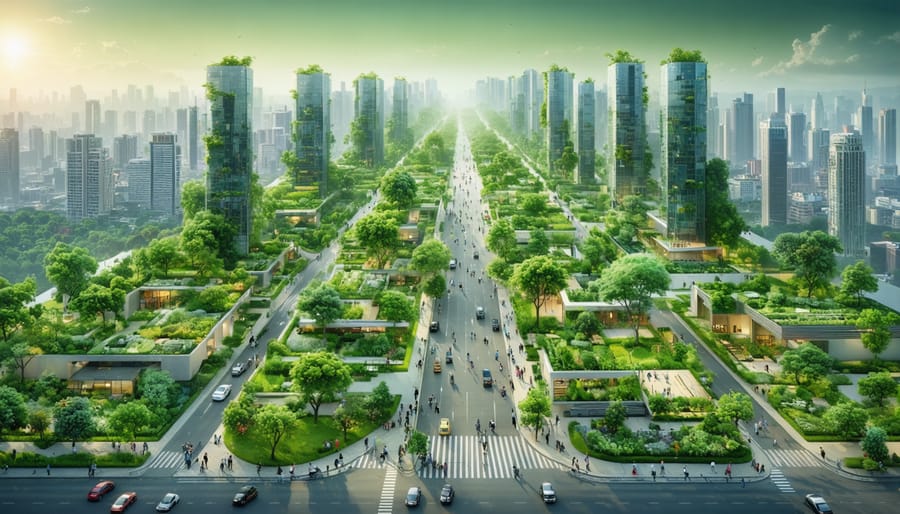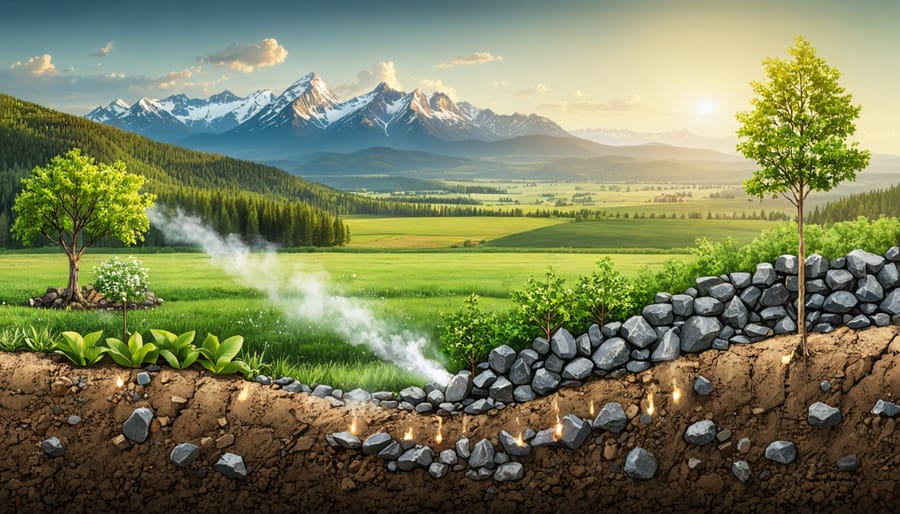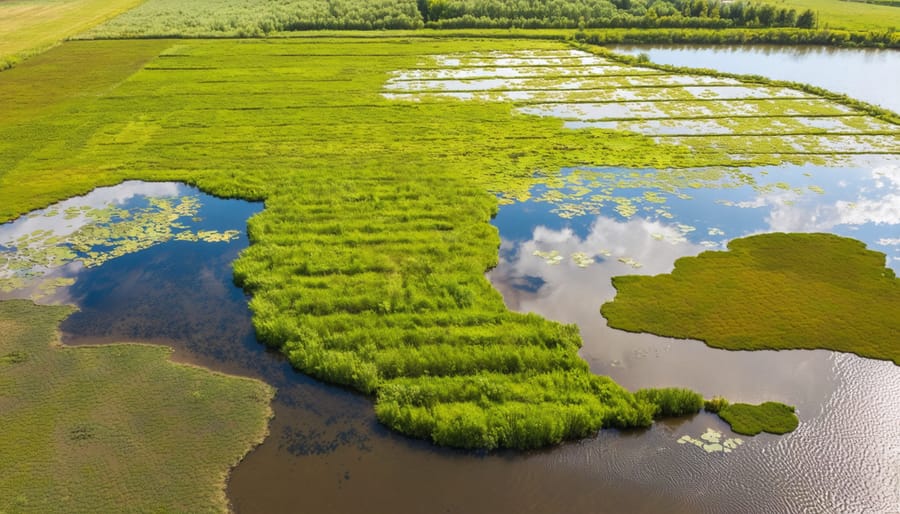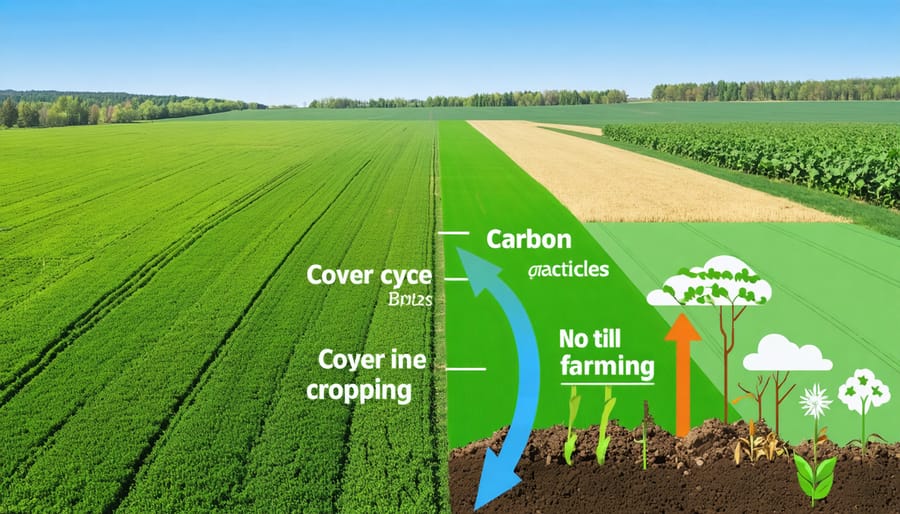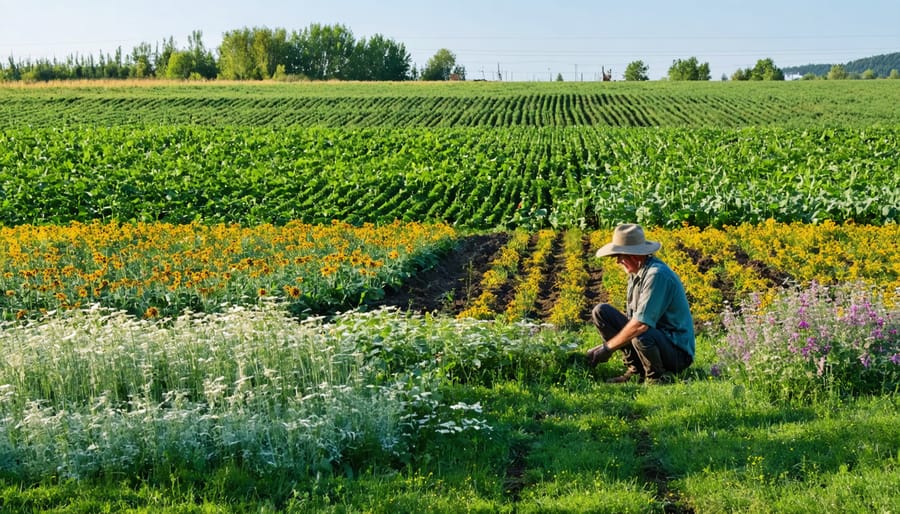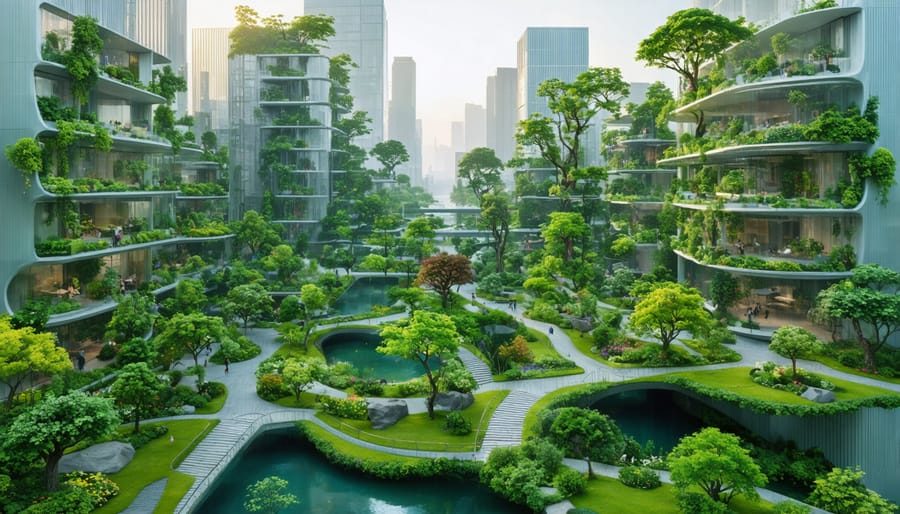Transform city landscapes into carbon-capturing powerhouses by integrating green infrastructure across urban spaces. Strategic placement of native trees, bioswales, and permeable surfaces reduces urban heat islands while sequestering significant amounts of carbon dioxide. Modern urban agroforestry initiatives boost biodiversity, manage stormwater runoff, and create resilient community spaces that adapt to climate change impacts.
Canadian municipalities leading this green revolution demonstrate how interconnected networks of parks, green roofs, and living walls deliver multiple environmental benefits while strengthening social connections. Calgary’s innovative green infrastructure projects, for example, now capture over 500,000 kg of carbon annually while reducing flood risks and cooling downtown temperatures by up to 3°C during summer months.
By reimagining urban design through the lens of natural systems, cities become active participants in climate change mitigation rather than contributors to the problem. This shift from grey to green infrastructure represents a crucial investment in our communities’ environmental and economic future.
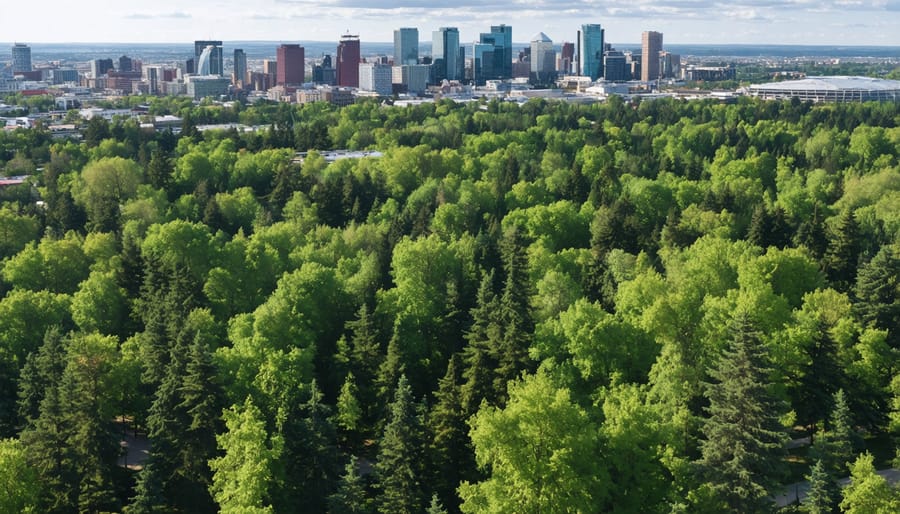
The Power of Urban Forests in Alberta’s Cities
Native Trees That Pack the Biggest Carbon Punch
In Alberta’s urban landscapes, certain native tree species excel at carbon sequestration strategies, making them ideal choices for green infrastructure projects. The White Spruce (Picea glauca) stands out as a carbon-storing powerhouse, capable of sequestering up to 2.5 tonnes of carbon dioxide over its lifetime when planted in optimal urban conditions.
Bur Oak (Quercus macrocarpa) and Green Ash (Fraxinus pennsylvanica) are particularly effective in our climate, with mature specimens storing approximately 1.8 and 1.6 tonnes of carbon dioxide respectively. These species also offer excellent shade coverage and wind protection, making them multi-functional additions to urban spaces.
The Trembling Aspen (Populus tremuloides), Alberta’s provincial tree, deserves special mention. While individual trees store moderate amounts of carbon, their clonal growth pattern creates interconnected root systems that enhance overall carbon storage capacity. A single aspen clone can sequester up to 15% more carbon than isolated trees.
For smaller urban spaces, the Manitoba Maple (Acer negundo) provides efficient carbon storage while adapting well to varied soil conditions. Paper Birch (Betula papyrifera) offers similar benefits while adding visual interest with its distinctive bark.
When planning urban forests, combining these species creates a resilient ecosystem that maximizes carbon capture. Recent studies from the University of Alberta suggest that mixed-species plantings can increase overall carbon sequestration by up to 30% compared to single-species stands. For best results, consider soil conditions, available space, and proximity to infrastructure when selecting these carbon-capturing champions.
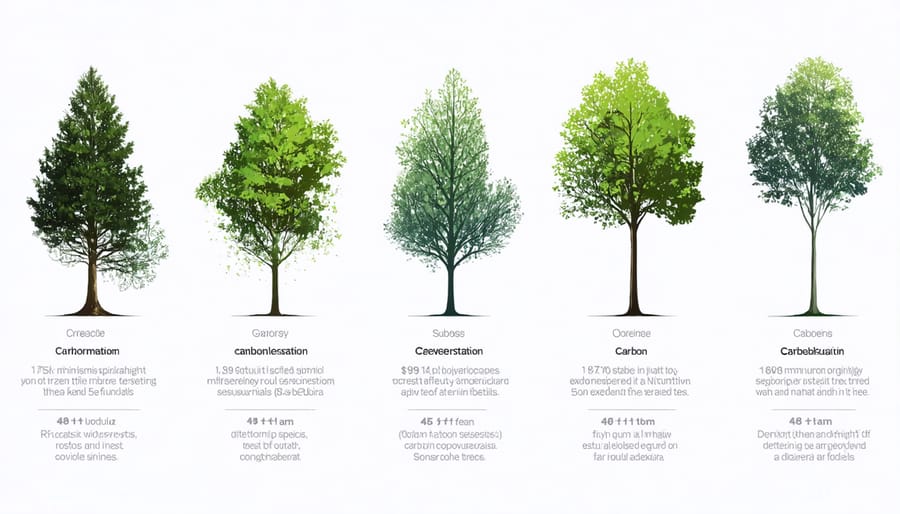
Beyond Trees: Green Roofs and Living Walls
When we look beyond traditional trees, green roofs and living walls offer exciting opportunities for urban carbon capture in Alberta’s cities. These vertical and rooftop gardens are transforming concrete surfaces into thriving ecosystems that work overtime to reduce our carbon footprint.
In Calgary, the SAIT Polytechnic’s green roof project has demonstrated impressive results, capturing an estimated 325 kg of carbon dioxide annually while reducing heating and cooling costs by 25%. The system uses hardy native species like Blue Grama Grass and Rocky Mountain Fescue, which are well-adapted to our prairie climate.
Living walls, or vertical gardens, are gaining traction in Edmonton’s commercial spaces. The Commerce Place building’s 223-square-metre living wall not only captures carbon but also improves indoor air quality and reduces energy consumption. These systems typically incorporate a mix of sedums, ferns, and flowering perennials that thrive in vertical environments.
For building owners considering implementation, key factors include:
– Structural assessment for weight-bearing capacity
– Selection of climate-appropriate plant species
– Installation of proper irrigation systems
– Regular maintenance planning
Local success stories include Edmonton’s Muttart Conservatory’s experimental green roof, which combines carbon capture with urban agriculture, growing vegetables and herbs while sequestering carbon. This dual-purpose approach has inspired similar projects across the province.
Maintenance costs average $25-35 per square metre annually, but the long-term benefits often outweigh the investment through energy savings and increased property values. Many municipalities now offer incentives for green roof installations, making these systems more accessible to property owners.
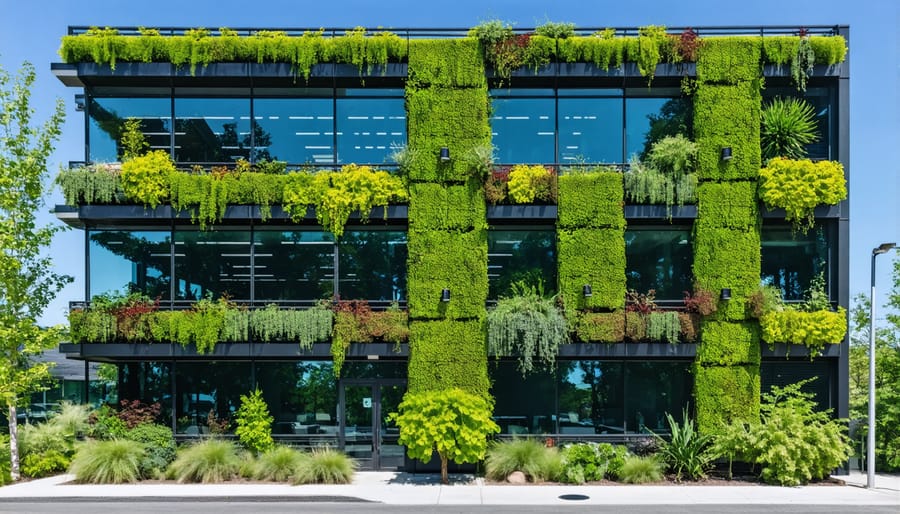
Smart Design Strategies for Maximum Impact
Strategic Placement for Optimal Results
When it comes to maximizing carbon sequestration in urban areas, strategic placement of green infrastructure is crucial. In Alberta’s urban centres, we’ve found that creating interconnected networks of green spaces yields better results than isolated installations.
Consider positioning larger trees along major roadways and in areas with high traffic volumes, where they can effectively capture vehicle emissions. Species like American Elm and Manitoba Maple have proven particularly effective in our climate, while providing substantial shade coverage.
For optimal impact, layer your green infrastructure vertically. Start with ground cover plants and shrubs, add medium-height vegetation, and top with canopy trees. This multi-tiered approach maximizes the carbon-capturing potential per square metre while creating diverse ecosystems.
Rain gardens and bioswales work best when positioned in natural drainage pathways. In Edmonton and Calgary, successful projects have shown that placing these features at the bottom of slopes or in low-lying areas not only captures more carbon but also manages stormwater more effectively.
Green roofs deliver the greatest benefit when installed on buildings with large, flat surfaces. Local experience shows that industrial buildings and community centres are ideal candidates, offering significant surface area for carbon sequestration while improving building energy efficiency.
Remember to account for future growth when planning placement. Trees and shrubs need adequate space to reach maturity, and proper spacing ensures optimal carbon capture capacity over time.
Integration with Existing Urban Systems
Integrating green infrastructure into existing urban systems requires thoughtful planning and collaboration between multiple stakeholders. In Alberta’s cities, successful implementation often starts with identifying opportunities within current infrastructure networks. Many municipalities are finding creative ways to incorporate green elements into stormwater management solutions, transportation corridors, and public spaces.
One effective approach is the retrofit method, where existing grey infrastructure is gradually enhanced with green elements. For example, Calgary has successfully integrated bioswales along major roadways, combining traditional drainage systems with natural filtration processes. Edmonton’s Green Network Strategy demonstrates how connecting fragmented green spaces can create cohesive ecological corridors while maintaining urban functionality.
Local communities are increasingly involved in these transitions, with neighbourhood-level projects leading the way. Rain gardens in residential areas, green roofs on commercial buildings, and urban food forests in community spaces show how green infrastructure can serve multiple purposes while fitting seamlessly into the urban fabric.
Municipalities are also updating building codes and development guidelines to ensure new projects incorporate green infrastructure from the start. This proactive approach helps reduce implementation costs and maximizes benefits for both urban systems and residents. The key is to view green infrastructure not as an add-on, but as an integral part of urban planning that enhances existing city services while building climate resilience.
Success Stories: Canadian Cities Leading the Way
Canadian cities are leading the charge in implementing innovative green infrastructure solutions, demonstrating remarkable success in urban sustainability. Edmonton’s Root for Trees initiative has become a standout example, planting over 311,000 trees since 2012 and creating vital urban forest corridors that help reduce the city’s carbon footprint while providing natural cooling during summer months.
Vancouver’s Rain City Strategy showcases how green infrastructure can effectively manage stormwater. The city has installed over 250 rain gardens and bioswales, reducing flooding risks while naturally filtering pollutants from water runoff. These installations have decreased the strain on traditional drainage systems by 40% in targeted areas.
Toronto’s Green Roof Bylaw, the first of its kind in North America, has led to the creation of more than 500 green roofs covering over 600,000 square metres. These living roofs have reduced urban heat island effects by up to 3°C in surrounding areas and cut building energy costs by an average of 15%.
Calgary’s Natural Infrastructure Assessment project demonstrates how natural assets can provide vital ecosystem services. The city’s wetland preservation efforts in Nose Creek have saved an estimated $8 million in artificial stormwater infrastructure costs while creating habitable spaces for local wildlife.
Montreal’s green alley program has transformed over 400 back alleys into vibrant community spaces filled with native plants and permeable surfaces. These green corridors have increased biodiversity, reduced urban heat, and strengthened community connections.
Halifax’s Urban Forest Master Plan has achieved an impressive 40% canopy coverage target in several neighbourhoods through strategic tree planting and preservation efforts. The initiative has improved air quality and created connected wildlife corridors throughout the city.
These success stories highlight how Canadian municipalities are effectively integrating nature-based solutions into urban planning, creating more resilient and livable cities while addressing climate change challenges. Their achievements provide valuable blueprints for other communities looking to enhance their green infrastructure.
Maintenance and Long-term Management
Maintaining urban green infrastructure requires a well-planned, systematic approach to ensure continued carbon sequestration and long-term environmental benefits. In Alberta’s climate, regular monitoring and seasonal maintenance are essential for optimal performance.
During spring, conduct thorough inspections of all green infrastructure components, particularly after winter thaw. Check for soil erosion, drainage issues, and plant health. Remove any dead vegetation and replace damaged plants with climate-appropriate species. For green roofs, ensure drainage systems are clear and membrane integrity is intact.
Summer maintenance focuses on irrigation management, especially during dry spells common in Alberta. Install moisture sensors to optimize water usage and prevent overwatering. Regular pruning helps maintain healthy growth and maximizes carbon capture potential. Consider implementing a rotating schedule for maintaining different sections to distribute workload effectively.
Fall preparation is crucial for winter survival. Remove fallen leaves from bioswales and rain gardens to prevent clogging. Apply mulch around plants to protect root systems from freeze-thaw cycles. Document all maintenance activities and outcomes to build a knowledge base for future improvements.
For long-term success, establish partnerships with local horticultural experts and environmental groups. Train maintenance staff in sustainable practices and proper equipment use. Consider implementing citizen science programs to engage the community in monitoring and maintaining green spaces. This approach not only reduces costs but also builds public awareness and support for urban green infrastructure initiatives.
Regular soil testing and carbon monitoring help track sequestration effectiveness and guide management decisions. Update maintenance protocols based on performance data and changing climate conditions to ensure continued success of your green infrastructure investments.
Urban green infrastructure represents a vital opportunity for Canadian communities to combat climate change while creating more livable cities. By implementing these sustainable solutions, we can significantly reduce carbon emissions, improve air quality, and enhance biodiversity in our urban environments. The success stories from Alberta’s municipalities demonstrate that with proper planning and community engagement, green infrastructure projects can thrive even in challenging climate conditions.
As we look to the future, every step toward incorporating more green spaces, sustainable drainage systems, and native plantings brings us closer to our environmental goals. Whether you’re a municipal planner, property developer, or concerned citizen, there’s a role for everyone in advancing urban green infrastructure. Let’s work together to transform our cities into resilient, sustainable communities that future generations will be proud to inherit. The time to act is now – start by implementing even small-scale green solutions in your local area.

